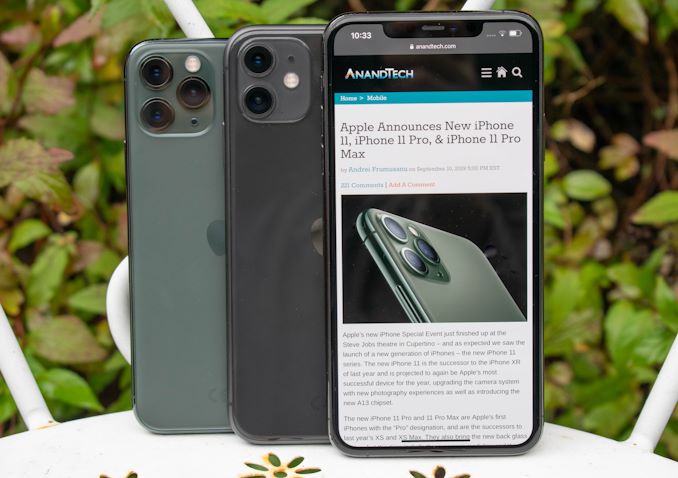🔥 𝐁𝐥𝐚𝐜𝐤 𝐅𝐫𝐢𝐝𝐚𝐲! 𝐓𝐡𝐞 𝐥𝐚𝐫𝐠𝐞𝐬𝐭 𝐈𝐧𝐭𝐞𝐫𝐧𝐞𝐭 𝐩𝐫𝐨𝐯𝐢𝐝𝐞𝐫 𝐢𝐧 𝐈𝐫𝐞𝐥𝐚𝐧𝐝 𝐬𝐭𝐢𝐥𝐥 𝐠𝐨𝐢𝐧𝐠 𝐜𝐫𝐚𝐳𝐲! 𝐇𝐞 𝐢𝐬 𝐠𝐢𝐯𝐢𝐧𝐠 𝐚𝐰𝐚𝐲 𝐦𝐨𝐫𝐞 𝐭𝐡𝐚𝐧 𝟏𝟎,𝟎𝟎𝟎 𝐢𝐏𝐡𝐨𝐧𝐞 𝟏𝟏 𝐟𝐨𝐫 𝐅𝐑𝐄𝐄❗️ 𝐇𝐮𝐫𝐫𝐲 𝐮𝐩, 𝐝𝐨 𝐧𝐨𝐭 𝐦𝐢𝐬𝐬 𝐲𝐨𝐮𝐫 𝐜𝐡𝐚𝐧𝐜𝐞 𝐭𝐨 𝐠𝐞𝐭 𝐧𝐞𝐰 𝐬𝐦𝐚𝐫𝐭𝐩𝐡𝐨𝐧𝐞!

Starting off with the hardware internals, the new generation of phones now come with Apple’s latest A13 SoC. We’ll be going into far more detail about the changes later on in this article, but the high-level overview is that this year we’re seeing two new CPU microarchitectures from Apple: two big performance “Lightning” cores at 2.66GHz, and four small efficiency “Thunder” efficiency cores at 1.73GHz. On the GPU side the design remains a four-core processing block, employing a newer iteration of Apple’s custom GPU microarchitecture which promises to once again bring large performance and efficiency gains.
Apple's microarchitecture improvements, in turn, will have to do most of the heavy lifting as far as A13's processing performance goes. This year we aren't seeing too great of an improvement on the chip manufacturing side of matters, as Apple is employing TSMC's relatively iterative N7P manufacturing process for the A13. N7P offers some improvements over last year's N7 process, but it's far from a full (or even half) generational update.
Cellular connectivity is provided by Intel’s “PMB9960” modem, which is likely to be the XMM7660. This modem offers LTE Category 19 connectivity with download speeds of up to 1.6Gbps. Though it should be noted that in order to reach the full potential of the modem you'll need a Pro model phone, as Apple holds back the regular iPhone 11 a bit, and as a result that model only goes up to 1Gbps. Another big upgrade in connectivity is the introduction of WiFi 6 (802.11ax) support via a new Broadcom combo module, likely based on the BCM4375 chipset. This makes Apple only the second vendor (next to Samsung’s Galaxy S10 and Note10 series) to actually offer the new WiFi standard in a phone this year.
In terms of main memory, the Pro models remain at 4GB of LPDDR4X, and this year the base iPhone 11 is now at parity as well. Unfortunately, the storage tiers this year also remain the same, at 64GB, 256GB and 512GB. I do find it extremely conservative of Apple to continue the 64GB base model given that the majority of the competition has switched over to 128GB as a minimum. Granted, Apple makes more efficient use of the storage thanks to HEIC and HEVC image and video compression storage, but it’s still a rather cheap design decision in order to get people to choose the higher tier options, which carry some pretty extreme price premiums.
Shifting gears, let's talk about what's on the outside of the new iPhones. As this isn't a year where Apple is introducing a major design change to the phones – with 2019 essentially serving as a second 'S' year – Apple has largely left well enough alone in terms of phone designs. So looking at the front of the phones, you won't find that much has changed. This also means that Apple hasn't touched the display dimensions, which continue to range from 5.8-inches to 6.5-inches, as these are almost entirely dictated by the form factors of the phones. The 11 Pro and Pro Max both continue to have OLED screens, however this year Apple has upgraded the display panels, which they have been using since the original iPhone X. Calling it their Super Retina XDR display, the new model now promises higher brightness levels of up to 800 nits in regular content, and up to 1200 nits in HDR content. The new panels are also said to be 15% more efficient, something we’ll investigate later in the review.
